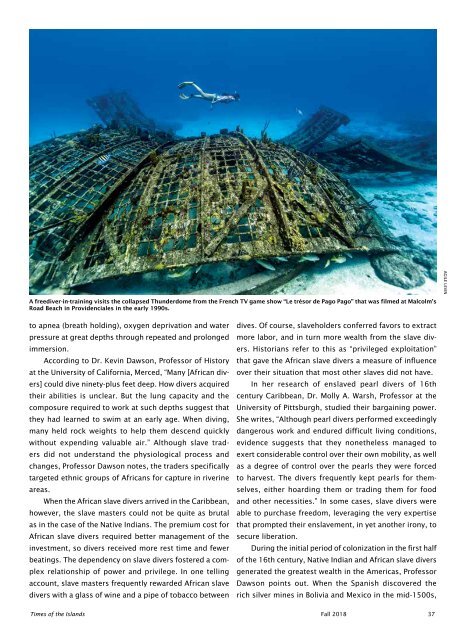Times of the Islands Fall 2018
Presents the "soul of the Turks & Caicos Islands" with in-depth features about local people, culture, history, environment, businesses, resorts, restaurants and activities.
Presents the "soul of the Turks & Caicos Islands" with in-depth features about local people, culture, history, environment, businesses, resorts, restaurants and activities.
Create successful ePaper yourself
Turn your PDF publications into a flip-book with our unique Google optimized e-Paper software.
A freediver-in-training visits <strong>the</strong> collapsed Thunderdome from <strong>the</strong> French TV game show “Le trésor de Pago Pago” that was filmed at Malcolm’s<br />
Road Beach in Providenciales in <strong>the</strong> early 1990s.<br />
AGILE LEVIN<br />
to apnea (breath holding), oxygen deprivation and water<br />
pressure at great depths through repeated and prolonged<br />
immersion.<br />
According to Dr. Kevin Dawson, Pr<strong>of</strong>essor <strong>of</strong> History<br />
at <strong>the</strong> University <strong>of</strong> California, Merced, “Many [African divers]<br />
could dive ninety-plus feet deep. How divers acquired<br />
<strong>the</strong>ir abilities is unclear. But <strong>the</strong> lung capacity and <strong>the</strong><br />
composure required to work at such depths suggest that<br />
<strong>the</strong>y had learned to swim at an early age. When diving,<br />
many held rock weights to help <strong>the</strong>m descend quickly<br />
without expending valuable air.” Although slave traders<br />
did not understand <strong>the</strong> physiological process and<br />
changes, Pr<strong>of</strong>essor Dawson notes, <strong>the</strong> traders specifically<br />
targeted ethnic groups <strong>of</strong> Africans for capture in riverine<br />
areas.<br />
When <strong>the</strong> African slave divers arrived in <strong>the</strong> Caribbean,<br />
however, <strong>the</strong> slave masters could not be quite as brutal<br />
as in <strong>the</strong> case <strong>of</strong> <strong>the</strong> Native Indians. The premium cost for<br />
African slave divers required better management <strong>of</strong> <strong>the</strong><br />
investment, so divers received more rest time and fewer<br />
beatings. The dependency on slave divers fostered a complex<br />
relationship <strong>of</strong> power and privilege. In one telling<br />
account, slave masters frequently rewarded African slave<br />
divers with a glass <strong>of</strong> wine and a pipe <strong>of</strong> tobacco between<br />
dives. Of course, slaveholders conferred favors to extract<br />
more labor, and in turn more wealth from <strong>the</strong> slave divers.<br />
Historians refer to this as “privileged exploitation”<br />
that gave <strong>the</strong> African slave divers a measure <strong>of</strong> influence<br />
over <strong>the</strong>ir situation that most o<strong>the</strong>r slaves did not have.<br />
In her research <strong>of</strong> enslaved pearl divers <strong>of</strong> 16th<br />
century Caribbean, Dr. Molly A. Warsh, Pr<strong>of</strong>essor at <strong>the</strong><br />
University <strong>of</strong> Pittsburgh, studied <strong>the</strong>ir bargaining power.<br />
She writes, “Although pearl divers performed exceedingly<br />
dangerous work and endured difficult living conditions,<br />
evidence suggests that <strong>the</strong>y none<strong>the</strong>less managed to<br />
exert considerable control over <strong>the</strong>ir own mobility, as well<br />
as a degree <strong>of</strong> control over <strong>the</strong> pearls <strong>the</strong>y were forced<br />
to harvest. The divers frequently kept pearls for <strong>the</strong>mselves,<br />
ei<strong>the</strong>r hoarding <strong>the</strong>m or trading <strong>the</strong>m for food<br />
and o<strong>the</strong>r necessities.” In some cases, slave divers were<br />
able to purchase freedom, leveraging <strong>the</strong> very expertise<br />
that prompted <strong>the</strong>ir enslavement, in yet ano<strong>the</strong>r irony, to<br />
secure liberation.<br />
During <strong>the</strong> initial period <strong>of</strong> colonization in <strong>the</strong> first half<br />
<strong>of</strong> <strong>the</strong> 16th century, Native Indian and African slave divers<br />
generated <strong>the</strong> greatest wealth in <strong>the</strong> Americas, Pr<strong>of</strong>essor<br />
Dawson points out. When <strong>the</strong> Spanish discovered <strong>the</strong><br />
rich silver mines in Bolivia and Mexico in <strong>the</strong> mid-1500s,<br />
<strong>Times</strong> <strong>of</strong> <strong>the</strong> <strong>Islands</strong> <strong>Fall</strong> <strong>2018</strong> 37

















